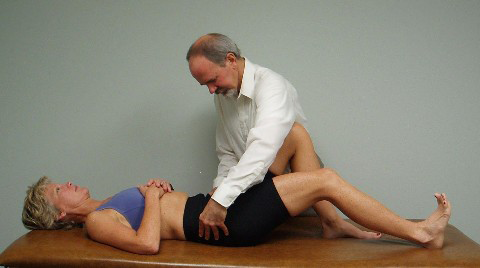Heel Slide How-To

Supine heel slides are commonly given to patients to help strengthen the abdominals and protect the low back. Patients have typically been instructed to either flatten their low back while doing this exercise or to find and maintain a neutral lumbar spine during the heel slide. Most patients are simply instructed to flatten then extend the low back and find the midpoint in between to obtain a neutral lumbar spine. The argument for maintaining a neutral lumbar spine versus flattening the low back is that by simultaneously engaging the posterior musculature to hold a neutral spine it will promote core stability. Historically, therapists have not paid attention to the stability of the innominates during the heel slide exercise. Mark found that when he placed his thumbs under both ASISs at the start of this exercise, the ASISs were most often asymmetrical to begin with, noting a predominance for the R ASIS appearing inferior to the L. He also noted that when monitoring the ASISs during the heel slide movement test, patients often did not keep the ASISs level, with the R ASIS often dropping inferiorly during R heel slide. This is indicative of anterior innominate rotation occurring in substitution for hip extension.
Mark also noted during his initial biomechanical evaluation that these patients presented with an anteriorly rotated R innominate. He surmised that if the patient was given the heel slide exercise without consciously maintaining leveling of the ASISs the patient was reinforcing this pelvic dysfunction. Therefore it is essential that the therapist monitors the ASISs during the performance of this movement test and teaches the patient to limit the degree of heel slide based upon their ability to maintain leveling of the ASISs.
In Rehab Links Module #5 you will learn how to specifically examine your subject using the supine heel slide test. In Rehab Links Module #6 the causes and manual treatment to address the premature movement of the innominate during this movement test are covered in detail. This is followed by the appropriate retraining exercises in Rehab Links Module #7 that are given to patients so that they can eventually perform the heel slide exercise without substituting with innominate rotation.
Lisa Chase and Mark Bookhout launched the Rehab Links Systems online platform – a unique exercise software for medical, health and fitness professionals – to help users link manual therapy treatments with a client-specific individualized home exercise program that results in improved clinical outcomes.
Click here to view the online module series and learn more. If you have already taken an exercise course with Bookhout Seminars or Back 2 Normal Institute, Rehab Links also enables you to deepen your knowledge through membership and mentoring opportunities.
